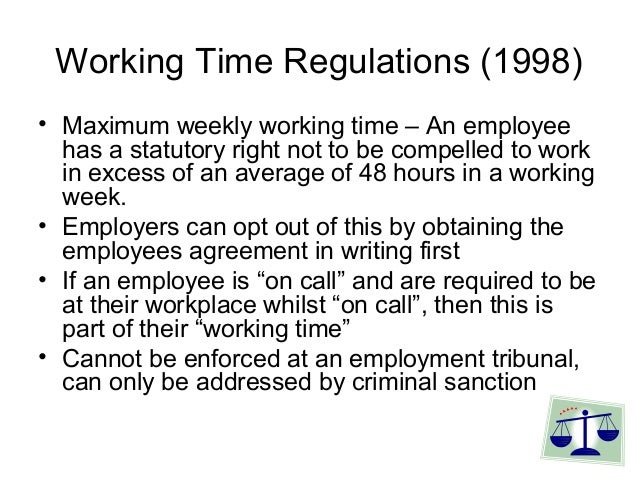Working Time Regulations 1998 Regulation 10
Working Time Regulations: What You Need to Know Introduction: The Working Time Regulations (WTR) of 1998 in the United Kingdom play a crucial role in protecting the rights of workers and ensuring a healthy work-life balance. These regulations govern various aspects of working time, including rest breaks, working hours, and holidays. In this article, we will explore the details of the Working Time Regulations, including Regulation 10, and provide you with a comprehensive guide to understanding and complying with these regulations. 1. Understanding the Working Time Regulations: a) Definition and Purpose: The Working Time Regulations (WTR) were introduced to implement the European Union's Working Time Directive. The primary objective of these regulations is to safeguard workers' health and safety by establishing limits on working time, providing adequate rest breaks, and ensuring sufficient annual leave. b) Applicability: The WTR applies to almost all workers in the United Kingdom, including full-time, part-time, temporary, and agency workers. However, there are some exceptions, such as certain sectors with specific working time arrangements, armed forces, and certain types of self-employed individuals. 2. Key Provisions of Regulation 10: Regulation 10 under the Working Time Regulations 1998 focuses on certain rights and obligations related to rest breaks and rest periods. Let us delve into the key provisions of this regulation: a) Statutory Rest Breaks: According to Regulation 10, if you are an adult worker (over 18 years old) and your daily working time is more than six hours, you are entitled to a minimum uninterrupted rest break of 20 minutes. This break allows you to relax and recharge your energy during the working day. b) Rest Periods: In addition to statutory rest breaks, Regulation 10 also covers the provision of rest periods between working days. Employers must ensure that their workers have a rest period of at least 11 consecutive hours in each 24-hour period. This provides workers with sufficient time to rest, recuperate, and maintain a healthy work-life balance. 3. Importance of Complying with the Working Time Regulations: a) Health and Safety: By adhering to the Working Time Regulations, employers can promote the health and safety of their employees. Adequate rest breaks and rest periods have been proven to reduce the risk of accidents, fatigue-related errors, and work-related health problems. Ensuring compliance with these regulations demonstrates a commitment to employee well-being. b) Work-Life Balance: The Working Time Regulations also play a crucial role in promoting a healthy work-life balance. By limiting excessive working hours and providing sufficient rest breaks, employees have the opportunity to spend quality time with their families, pursue personal interests, and maintain their overall well-being. c) Legal Compliance: Complying with the working time provisions is not only beneficial for employees but also necessary to meet legal requirements. Failure to comply with the Working Time Regulations can result in legal consequences for employers, including financial penalties and potential legal disputes. It is essential for employers to understand and comply with these regulations to maintain a positive working environment. 4. Frequently Asked Questions (FAQs): a) Are all workers entitled to the same rest breaks? No, the entitlement to rest breaks may vary depending on the age of the worker and the duration of their working day. Adult workers (over 18 years old) who work more than six hours are entitled to a minimum 20-minute rest break. Young workers (aged 16-17) are entitled to a minimum 30-minute break if their working day exceeds four and a half hours. b) Can rest breaks be split into shorter intervals? Yes, rest breaks can be split into shorter intervals if it is not reasonably practicable for the employee to take a single uninterrupted break. However, the total duration of rest breaks should still amount to the required minimum, as specified by the Working Time Regulations. c) Can workers opt-out of the Working Time Regulations? Yes, workers can choose to opt-out of the maximum weekly working time limits prescribed by the regulations. However, this opt-out option does not apply to the provisions related to rest breaks and rest periods. Workers who make use of the opt-out must do so voluntarily and provide their agreement in writing. 5. Benefits of the Working Time Regulations: a) Improved Productivity: Research has shown that excessive working hours can lead to decreased productivity and increased risk of burnout. By implementing the Working Time Regulations, employers can enhance productivity by ensuring that their employees are well-rested, motivated, and able to maintain a healthy work-life balance. b) Better Employee Retention: A positive work-life balance is a crucial factor for employee satisfaction and retention. By complying with the Working Time Regulations, employers can demonstrate their commitment to their employees' well-being, leading to higher job satisfaction and increased loyalty. c) Legal Protection: The Working Time Regulations provide legal protection to workers, ensuring that their rights to rest breaks, rest periods, and annual leave are upheld. Compliance with these regulations helps employers maintain a positive reputation and avoid potential legal disputes. Conclusion: The Working Time Regulations 1998, particularly Regulation 10, play a significant role in protecting workers' rights and promoting a healthy work-life balance. By adhering to these regulations, employers can prioritize the well-being of their employees, improve productivity, and maintain legal compliance. It is essential for both employers and workers to have a comprehensive understanding of these regulations to foster a positive and harmonious working environment.  Image Source : pjhlaw.co.uk
Image Source : pjhlaw.co.uk  Image Source : www.slideshare.net
Image Source : www.slideshare.net  Image Source : www.lawdonut.co.uk
Image Source : www.lawdonut.co.uk  Image Source : amazon.co.uk
Image Source : amazon.co.uk  Image Source : www.poolealcock.co.uk
Image Source : www.poolealcock.co.uk  Image Source : www.pmprecruitment.co.uk
Image Source : www.pmprecruitment.co.uk  Image Source : connecdem.com
Image Source : connecdem.com  Image Source : bookdepository.com
Image Source : bookdepository.com
Working Time Regulations | Employment Tribunal | PJH Law
 Image Source : pjhlaw.co.uk
Image Source : pjhlaw.co.uk working time regulations directive law pjh higher santos gomes ltd level care european case
HRM Legislation Slides
 Image Source : www.slideshare.net
Image Source : www.slideshare.net hrm legislation
Working Time Regulations | Business Law Donut
 Image Source : www.lawdonut.co.uk
Image Source : www.lawdonut.co.uk regulations employees lawdonut
Working Time Regulations, 1998: A Practical Guide (Legal Guidance
working time regulations 1998 practical guidance legal guide amazon
Can You Opt Out Of The Working Time Regulations? - Poole Alcock
 Image Source : www.poolealcock.co.uk
Image Source : www.poolealcock.co.uk regulations
Working Time Regulations 1998 Update - PMP Recruitment
 Image Source : www.pmprecruitment.co.uk
Image Source : www.pmprecruitment.co.uk time working regulations 1998 update
What You Need To Know About Working Time Regulations - Connecdem.com
 Image Source : connecdem.com
Image Source : connecdem.com Working Time Regulations, 1998
regulations working time 1998
Time working regulations 1998 update. Regulations working time 1998. Working time regulations, 1998. Working time regulations directive law pjh higher santos gomes ltd level care european case. Working time regulations 1998 update